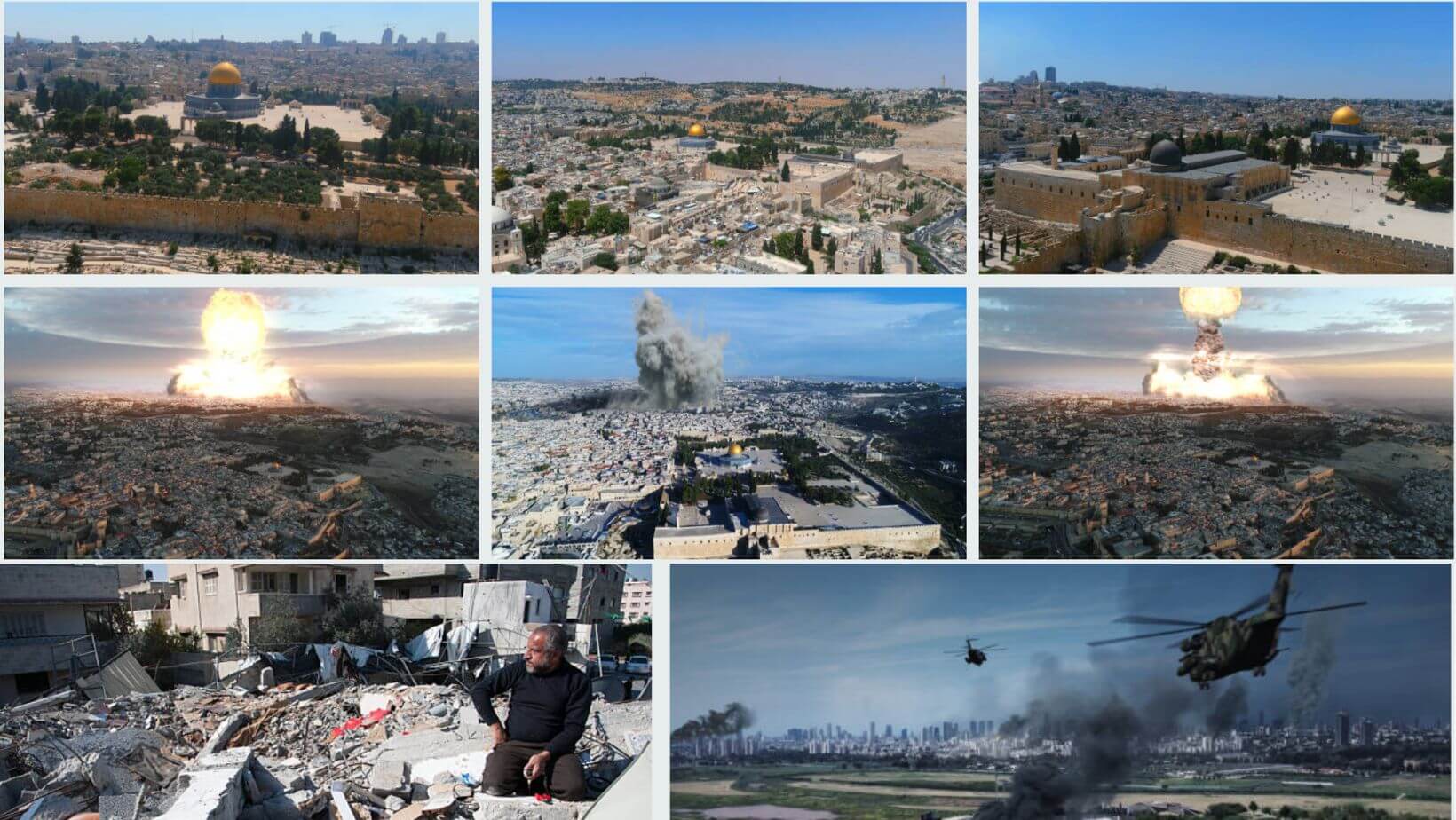Fake images of the war in Israel and Gaza make it difficult to separate truth from fiction
Inflammatory images of Jerusalem in rubble or the Dome of the Rock surrounded by smoke are available on Adobe and iStock

Fake images of explosions in Jerusalem mingle with real photos of the Dome of the Rock and people in Gaza. Courtesy of iStock
When you search for images of the Israel-Hamas war on Adobe Stock, a paid stock image repository, you get a poignant photo of a woman in a dark dress and hijab, looking out over a field of rubble and dust. She holds the hand of a young boy.
If you’d prefer, though, the woman can ditch her hijab, or change her coat to a lighter color. The child’s shirt, however, is always orange.
“Mother and child in destroyed city in Palestine,” they’re all titled. “Generative AI.”
Fake, AI-generated photorealistic images of the war are flooding stock image sites — sites journalists and bloggers often subscribe to for images they can use to illustrate their work.
On iStock, you can find a photo-like image showing pillars of smoke rising from Jerusalem’s Old City. Though it’s labeled as an “aerial view” of war, small type indicates that the image is a “3D rendering.”
Or, if you would like to use video, there are several of a nuclear bomb exploding in Jerusalem or Tel Aviv, labeled as “drone view” of a “dirty bomb exploding.” Though these are not labeled as renderings, one can assume that if a nuclear bomb was dropped on Jerusalem, the world would know about it.
To make things more confusing, real photos from the conflict over the past several years, including 2021 photos of bombed buildings in Gaza, are mixed in with the AI results.
Tech site Futurism found that several small news outlets had already used some of the generated images, including one of a plume of black smoke rising from a city that appears to be in Israel or Gaza.
By Thursday, iStock appeared to be in the process of removing some of the more incendiary faked images from their site; while images of helicopters and buildings on fire still showed up on the search, they could not be downloaded.
Most photo sites rely on user submissions, but the levels of oversight vary. Getty Images, which supplies many major outlets with professional editorial photos from photojournalists, thoroughly vets its editorial photographers, requiring them to submit portfolios and credentials to be reviewed for weeks. But stock image sites let basically anyone upload.
Contributor pages for iStock, which is owned by Getty Images, and Adobe simply require contributors to own the rights to any images they upload. These can be illustrations, staged photos, general photos or computer renderings. If they contain recognizable, real people, those people need to have signed releases; if it’s AI, it simply must be labeled as such somewhere. iStock doesn’t accept AI images from major AI sites such as Midjourney, but it does accept computer renderings; at press time, the company had not responded to a request for comment on their policy.
Stock images are not meant to be used by journalists breaking news; instead, they’re geared toward recipes, think pieces and other general topics.
Still, though no one would be tempted to use a cartoon illustration or sketch drawing to illustrate breaking war news, someone moving quickly — especially if they don’t pay for the expensive Getty Images editorial subscription — might grab a photorealistic image that looks relevant without noticing it’s fake.
Misinformation has run rampant throughout the Israel-Hamas war. In the early days, a faked White House document about aid to Israel, a fabricated BBC article about arms sales to Hamas and clips purportedly of bombs falling in Gaza and Israel that were actually from a video game all circulated widely online until journalists debunked them.
The toxic slurry of misinformation combined with the difficulty of ascertaining the facts during the fog of war has made people increasingly mistrustful.
This not only causes fake news to spread, it also causes people to doubt the veracity of real photographic evidence. In the wake of Hamas’ Oct 7. terror attack, some people who were suspicious of Israel to begin with began to deny Israel’s claims of dead children and attacked civilians. When Israeli government channels published images of bloodied children’s bedrooms and burnt corpses, people claimed they were staged, or faked using AI.

It’s hard enough to know the truth in the fog of war without being able to shrug off facts as realistic fakes, or embrace realistic fakes as facts. And it’s hard to report the truth to an untrusting audience when some reporters are getting duped by images.
For now, we’ll have to just do our best to spot the fakes. Most are pretty good, but every now and then you can catch a giveaway. One set of images, showing Jerusalem burning, has a telling mistake: a giant flying saucer hovering over the Old City.

















